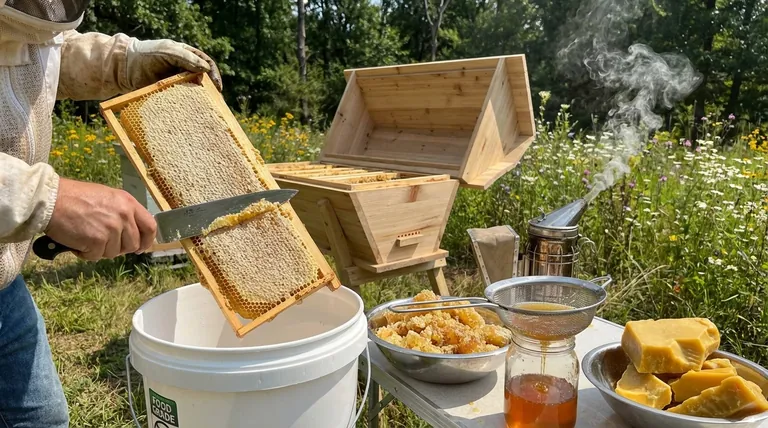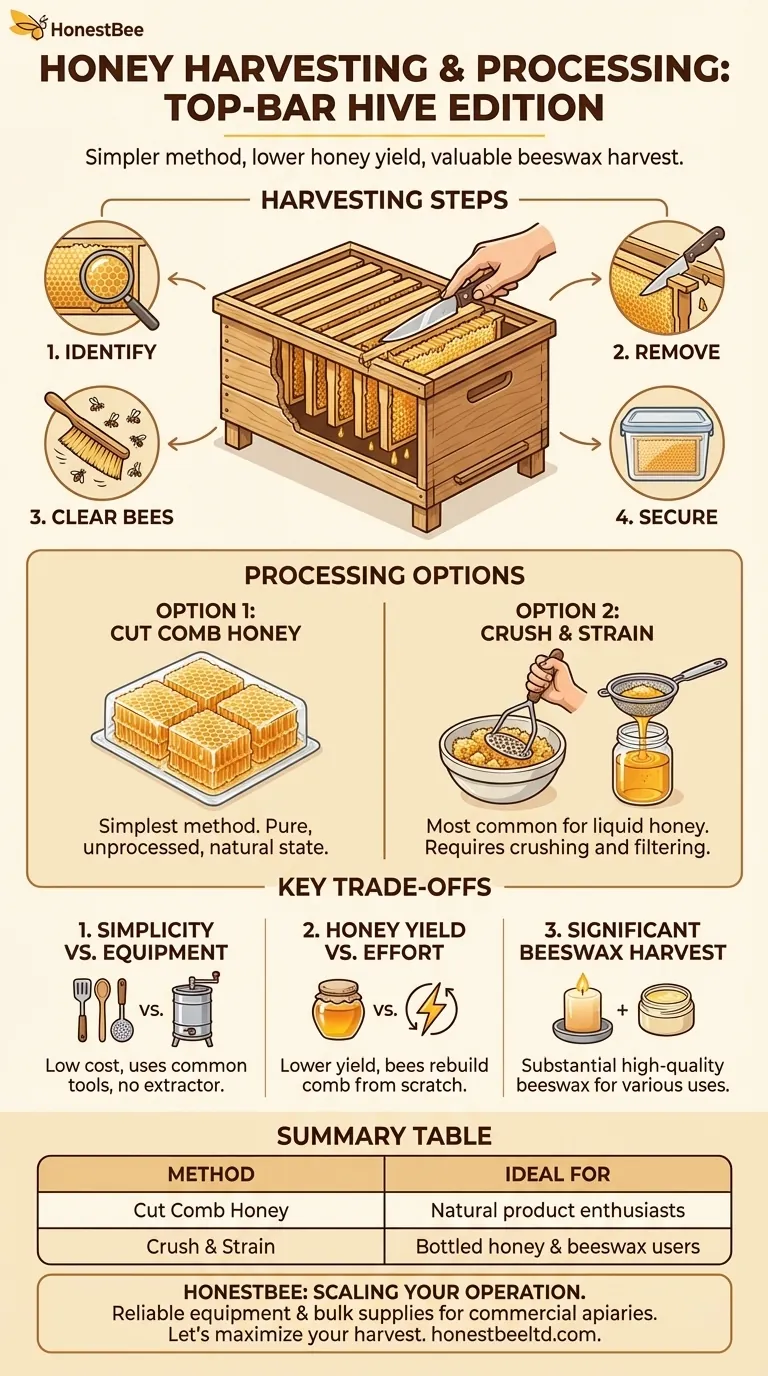The fundamental method for harvesting honey from a top-bar hive is by cutting the entire comb from the top bar. Because these combs are not supported by frames, they cannot be spun in an extractor. Instead, you process the honey by either keeping it as cut comb or by using a simple "crush and strain" method to separate the liquid honey from the beeswax.
The core difference in top-bar beekeeping is that honey harvesting is a simpler, low-equipment process, but it requires the bees to rebuild the comb every time. This results in a lower overall honey yield but provides a significant and valuable harvest of beeswax.

How to Harvest Honeycomb from a Top-Bar Hive
Harvesting from a top-bar hive is a straightforward process that feels more direct and less industrial than other methods. It requires minimal specialized equipment.
Identifying the Right Combs
First, you must identify combs that are ready for harvest. Look for combs that are filled with honey and are mostly, if not fully, "capped" with a white layer of beeswax. This indicates the bees have finished processing the nectar and the honey is at the correct moisture content.
Removing the Comb
Using a simple kitchen knife, carefully cut the comb away from the top bar and the sides of the hive. Work gently and smoothly to minimize disruption to the colony.
Clearing the Bees
The quickest way to clear the comb is to hold it over the open hive and firmly brush the bees off with a bee brush or a gentle shake. This encourages them to return directly to the hive.
Securing Your Harvest
Once the bees are off, immediately place the honeycomb into a food-grade, sealed container. This prevents bees from your hive (and others) from trying to rob the honey back.
Your Two Options for Processing Top-Bar Honey
Once you have the comb safely away from the hive, you have two primary choices for how to process it, each with distinct advantages.
Option 1: Cut Comb Honey
This is the simplest method. You simply cut the clean, capped honeycomb into desired sizes and package it. It is a pure, unprocessed product that many people value for its natural state.
Option 2: Crush and Strain for Liquid Honey
This is the most common method for getting liquid honey from a top-bar hive. The process involves breaking up the comb to release the honey and then filtering it.
The technique requires basic kitchen utensils: a large bowl or food-grade bucket, a potato masher or your clean hands to crush the comb, and a strainer or cheesecloth to separate the honey from the wax.
The Valuable Byproduct: Beeswax
Unlike methods where the comb is reused, the crush and strain process leaves you with all the beeswax. This wax can be cleaned and rendered down for use in making candles, balms, or polishes.
Understanding the Key Trade-offs
The top-bar method of harvesting comes with a distinct set of advantages and disadvantages compared to frame-based hives.
Simplicity vs. Specialized Equipment
Harvesting from a top-bar hive is exceptionally simple and low-cost. You can accomplish it with tools you likely already have in your kitchen, avoiding the need for an expensive honey extractor.
Honey Yield vs. Hive Effort
Because the entire comb is removed, the bees must expend significant energy and resources to rebuild it from scratch. This results in a lower overall honey production compared to Langstroth hives, where empty combs are returned to be refilled.
A Significant Beeswax Harvest
The major benefit of destroying the comb is a substantial and high-quality beeswax harvest. For beekeepers interested in self-sufficiency or creating other products, this is a significant advantage.
Making the Right Choice for Your Goal
Your approach to processing depends entirely on your desired final product.
- If your primary focus is the most natural, unprocessed product: Simply package your harvest as cut comb honey.
- If your primary focus is versatile liquid honey: Use the crush and strain method to produce bottled honey for cooking, tea, or sale.
- If your primary focus is utilizing every resource from the hive: Crush and strain the honey, then take the extra step to clean and render the leftover beeswax for other projects.
Ultimately, harvesting from a top-bar hive offers a direct and rewarding connection to the work of your bees and the products of the hive.
Summary Table:
| Processing Method | Key Feature | Ideal For |
|---|---|---|
| Cut Comb Honey | Pure, unprocessed comb | Natural product enthusiasts |
| Crush & Strain | Separates liquid honey from wax | Beekeepers wanting bottled honey & beeswax |
Ready to Scale Your Beekeeping Operation?
As a commercial apiary or equipment distributor, you need reliable, high-volume supplies. HONESTBEE provides the durable equipment and bulk supplies—from hive components to protective gear—that your business depends on.
Let us help you streamline your operations and maximize your harvest. Contact our wholesale team today to discuss your needs and request a quote.
Visual Guide

Related Products
- Top Bar Beehive for Beekeeping Wholesales Kenya Top Bar Hive
- Long Langstroth Style Horizontal Top Bar Hive for Wholesale
- HONESTBEE Professional Multi-Functional Hive Tool with Ergonomic Wood Handle
- HONESTBEE Advanced Ergonomic Stainless Steel Hive Tool for Beekeeping
- HONESTBEE Professional Long Handled Hive Tool with Precision Cutting Blade
People Also Ask
- What are the benefits of extra wax production in top bar hives? A Natural Byproduct for Craft & Efficiency
- Why are hive inspections easier with Top Bar Hives? Achieve a Calmer, Safer Approach to Beekeeping
- What is the quickest method to harvest honey from a top bar hive? A Guide to the Simple 'Cut and Crush' Method
- What are the key features of the Kenyan Top Bar Hive? A Guide to Simpler, Natural Beekeeping
- What are the benefits of a top bar hive? A Natural, Low-Impact Approach to Beekeeping



















